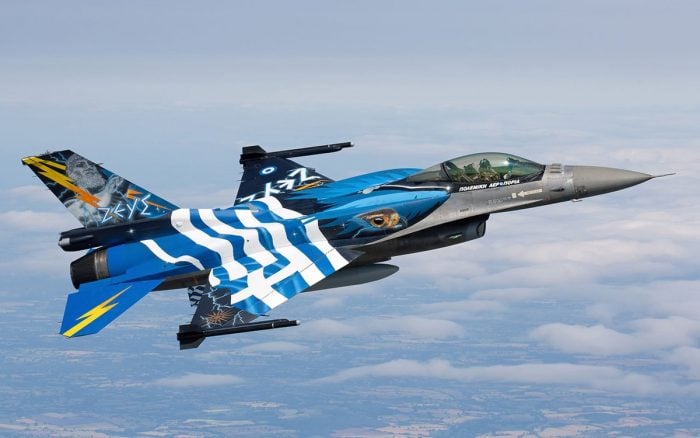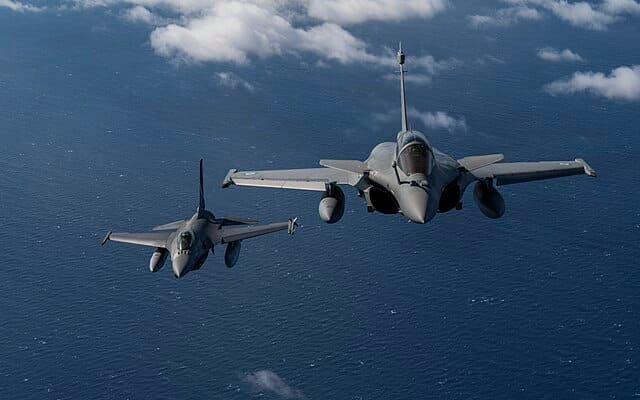
The Greek military possesses impressive capabilities, but there remains room for improvement given the country’s geostrategic location, according to US analyst Michael Shurkin, Ph.D.
Shurkin, a Washington, DC-based analyst, consultant, and researcher, has over twenty years of experience working in defense, intelligence, and national security. He is an expert in military strategy, West Africa, Europe, and the Middle East and a consultant for militaries, governments, and organizations, providing tailored analysis and research.
Based on his analysis, Greece is among NATO’s highest spenders in terms of the percentage of GDP allocated to defense and armaments, having spent over five percent of its GDP in the 1980s and never falling below two percent, even during the sovereign debt crisis in 2012, when it stood at 2.3 percent. In 2023, it rose to 3.2 percent of GDP, following the Greek economy‘s gradual recovery.
So far in 2025, Greece has spent 6.1 billion euros as part of the military’s Agenda 2030 plan. The Greek government also announced a 12-year spending package totaling 25 billion euros. The analyst explains that such spending is driven by ongoing tensions with Turkey over sovereign rights, which have obliged Greece to allocate as much as it possibly can to maintain its military at a high level of readiness.
However, Shurkin says, modern weaponry is extremely expensive, and only the United States can acquire top-tier weapons in large quantities. The Greek military currently possesses a small number of top-quality arms and a large inventory of older weapons that are gradually modernized to remain competitive against potential adversaries. The Greeks believe that they can balance quality with quantity, but certain compromises will need to be made, the analyst argues.
Greek military policy and strategic culture
In 1997, Greece developed a white paper on defense policy, which remains valid to this day in respect to the major contours of the policy. The government is focusing on the Aegean Sea in relation to Turkey. With approximately 14,000 kilometers (8,500 miles) of coastline, keeping the Greek military constantly on guard is an obvious priority.
The white paper states: Greece is unfortunately obliged to confront the challenges of a changing international environment and to respond to Turkey’s policy toward Greece and Cyprus. Turkey’s revisionist policy toward Greece, as demonstrated in the Aegean, Cyprus, and Thrace, is cause for serious concern and is considered the most significant threat to Greek security.
The aims of the national defense policy are, first of all, to keep the peace, safeguard the country’s territorial integrity, and protect national independence, sovereignty, and security of the Greek people from any external attack or threat; and second, to guarantee the security of Cypriot Hellenism and ensure the protection of Hellenic minorities abroad.
The central axis of Greek military strategy is the deterrence of the Turkish threat as well as risks from other directions, in combination with a policy of easing tensions. The country’s military doctrine is defensive. Greece aims to boost the operational capabilities of the Hellenic Armed Forces to achieve an effective deterrence policy, which should be constant, undiminished, and convincing with the two core elements being:
- credibility, or the declaration of the country’s intention to react if challenged;
- capability, or the ability to respond to an attack.
Greece’s national strategy consists of three elements, namely defensive sufficiency, flexibility in responding, and the ability to cover the “Greece-Cyprus Joint Defense Area” effectively.
Greece’s defensive sufficiency
The concept of the country’s defensive sufficiency policy offers an alternative to the arms race between Greece and Turkey. It targets securing all necessary defense means and ensuring the quality of manpower as the essential conditions for deterring any threat. Rather than trying to match Turkey in sheer numbers, the policy emphasizes cost-effective strategies, modern technology, and well-trained forces to achieve effective deterrence. At the same time, it necessitates a systematic effort to introduce new technology and weapon systems that ensure the maximization of cost-effectiveness.
Greece cannot compete directly with Turkey, which has a population approximately eight times larger and proportionally greater troop numbers and resources for weaponry. Therefore, Greece should focus on deterring such military threats. According to the American analyst, Greece needs to employ weapons and tactics capable of inflicting significant damage to Turkish forces so that Ankara will think twice before acting as the aggressor.
In April 2024, Greece drew up the Agenda 2030, a project to modernize the Hellenic Armed Forces. The aim is to give the Greek military a more offensive footing based on the principle that offense can be the best defense.
Currently, Turkey contests Greek and Cypriot exclusive economic zones (EEZ) by drawing its own, which interfere with those of its presumed rivals. Turkey has also blocked efforts of ships searching for hydrocarbon reserves in the Greek and Cypriot EEZs. In a recent bilateral agreement, Turkey and Libya drew an arbitrary and illegal EEZ, violating the EEZs of both Greece and Cyprus, as well as their territorial waters.
Overview of Greek military
Although there are no official figures of the total number of Hellenic Armed Forces personnel, according to Shurkin they amount to 419,000 people, of which 142,000 are active soldiers, 221,000 reservists, and 55,000 paramilitary personnel. The larger numbers of reservists compared to active soldiers means that Greece’s main concern is its involvement in a major war against a peer and not minor wars, small-scale military operations, or crisis management.
The army has 271,500 personnel, of which 90,000 are in active duty and 181,500 are reservists. Its weapon inventory is a mix of old and new. The large proportion of older equipment reflects budget constraints, according to the analyst. This is the compromise Greece has made. The army possesses 1,344 battle tanks, of which 350 are modern Leopard 2s. The remainder consists of older Leopard 1s and 181 modernized Greek M-48 and M-60 tanks.
Greece also has 181 infantry fighting vehicles, including the modernized BMP-1 purchased from East Germany. Recently, the Hellenic Armed Forces signed a deal with France to produce their own VBCI fighting vehicles to replace them, and they also plan to procure German Lynx infantry fighting vehicles. As for armored personnel carriers, they have 2,486, most of them older US M113s, which have the advantage of being amphibious and capable of moving between islands, and there are plans to modernize these. They also have Greek-manufactured Leonidas-2 infantry fighting vehicles.
The Hellenic Army plans to modernize its infantry carriers further by adding spikes to enhance capabilities in urban warfare and close-quarters combat. It also has 408 diverse ATGM carriers (Anti-Tank Guided Missile vehicles), 152 rocket artillery systems, 589 tank artillery systems, 698 artillery systems of various kinds, 98 French-made Crotale short-range air defense systems, 10 long-range MIM-104 Patriot missile systems, as well as older Tor and Hawk systems and 366 anti-aircraft guns.
There is also a large number of helicopters, including Apache, Chinook, and Black Hawk models, and Greek military personnel and equipment are stationed strategically across the country, with particular attention given to defending the region of Thrace, which borders Turkey.
Greek Air Force and Navy
The Hellenic Air Force has recently been augmented by the new French Rafale fighter jets, creating a mix of old and new aircraft. There are 67,000 personnel in total, with 33,000 on active duty and 32,000 in the reserves.
The Hellenic Air Force operates 200 fighter jets, of which 24 are Rafale, 154 are F-16s, and 42 are Mirage 2000. They also have 33 F-4 Phantom air bombers.
Τhe Hellenic Navy is not as large as one might expect for a country surrounded by the sea, especially given that its neighbor actively contests the sovereignty of some of its islands. Among its thirteen frigates, it has four top-tire FDI Kimon class frigates, nine submarines, fifteen missile boats, ten gunboats, eight patrol boats, thirteen special operator boats, and several auxiliary craft.
The focus of the Hellenic Navy is defending the country’s territorial waters. Until recently, Greek naval forces were concentrated in a fast-attack fleet in the Aegean, but in recent years, the Greek military has aimed at expanding its presence in the Eastern Mediterranean. The smaller ships are now equipped with spikes, and submarines have been modernized and given longer strike capabilities with cruise missiles. However, the Greek Navy has not abandoned the fast-attack fleet concept.

Agenda 2030 and the Achilles Shield
The newer focus of the Hellenic Armed Forces is power projection and extending Greece’s defensive umbrella across the Mediterranean. Greece is leveraging AI, advanced communication systems, and modern command and control technologies.
To achieve this, it is committed to purchasing 28 F-35 fighter jets, a new FDI frigate, upgrading existing submarines and acquiring two more, modernizing fast-attack boats, and upgrading M113 armored personnel carriers. The military is also investing heavily in drones, American Switchblade loitering munitions, French surveillance and patrol systems, Israeli MLRS (Multiple Launch Rocket Systems), and cyber and digital warfare capabilities.
According to Shurkin, Greece’s Achilles Shield program is an attempt to replicate Israel’s Iron Dome air defense system, which defended the country from Iranian missile attacks in June. The system is designed to counter everything from ballistic missiles to cruise missiles and short-range rockets fired from Gaza. The Greek system, however, also aims to include surface and underwater naval defenses to address threats from the Aegean Sea. The Achilles Shield project was announced by Defense Minister Nikos Dendias in 2024.
In this defense system, the Greeks aim to integrate existing capabilities, Shurkin says. They already operate Patriot missiles and plan to acquire additional systems, along with as much new war technology as possible. They also plan on purchasing significant Israeli equipment, such as the Spyder short- to medium-range air defense system and the Barak long-range system, and are evaluating the Arrow anti-ballistic missile system. At the same time, they intend to invest in the domestic defense industry to manufacture weapons in Greece.
Assessment of Greek military arsenal
Shurkin argues that the Greek military is impressive in terms of overall capability, at least on paper, deeming it one of the best in NATO. For further improvement, a balanced combination of quality and quantity is needed. Using, for instance, the Russia-Ukraine war as an example, he notes that an M48 tank cannot compete with a Leopard 2. However, having an M48 to face a Leopard is better than having nothing at all.
Greece is also working on modernizing the M48, the M60, the Leopard 1, and other older weapons in its inventory to make them all more efficient in battle, but what it also needs to do, the US analyst advises, is acquire more long-range missile defense systems. Moreover, he recommends that Greece purchase additional long-range missiles, which can be deployed on mobile launching vehicles. Static launching pads should be avoided due to their lack of flexibility.
Shurkin stresses the importance of enhancing coastal defense capabilities. His advice is that Greece create an island defense chain and disperse its forces as widely as possible across it. This is made feasible by the Achilles Shield program, as dispersing anti-air and naval assets, such as missiles, is now easier thanks to advanced coordination and communications technology. Coordinating such dispersed resources would have been impossible prior to the availability of these technologies.


